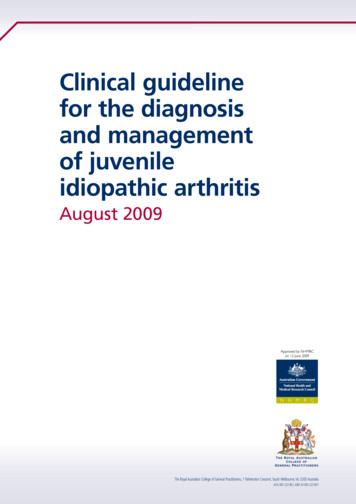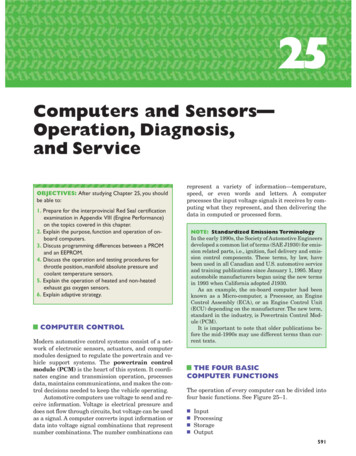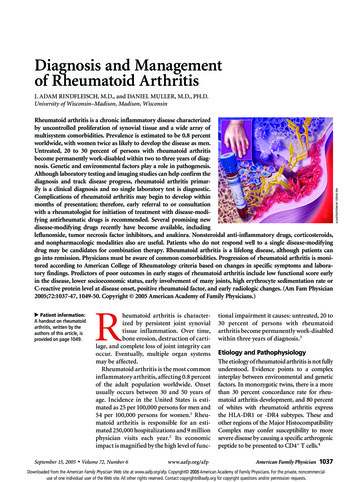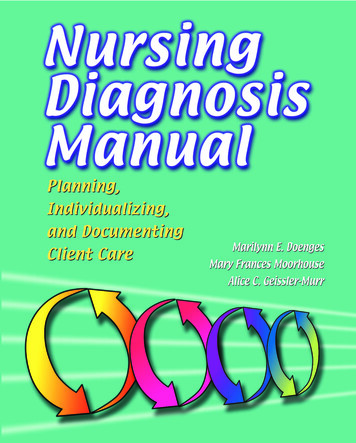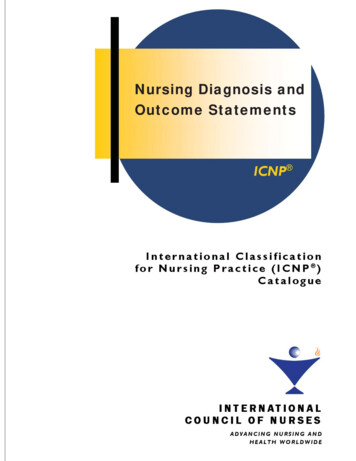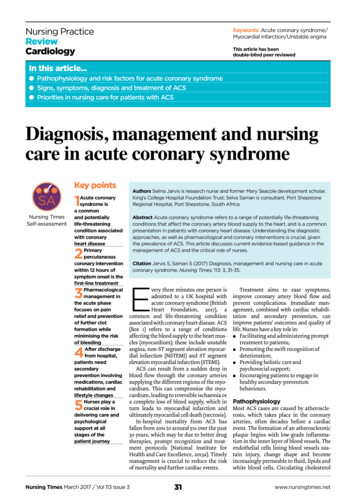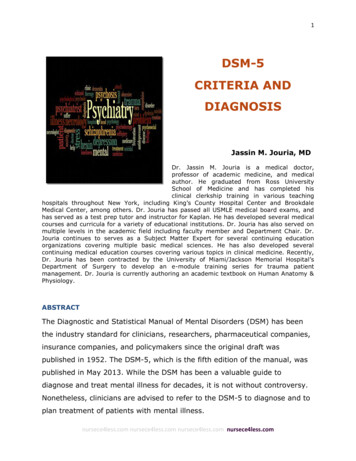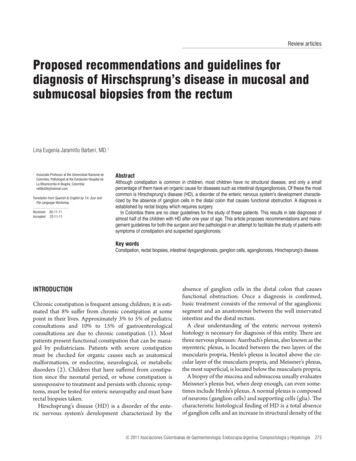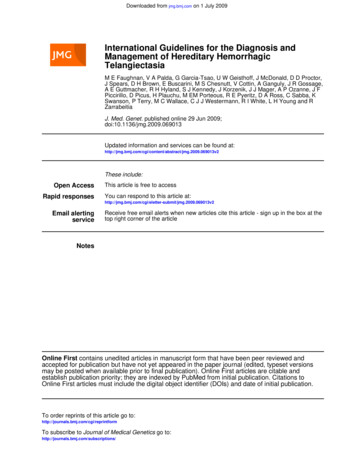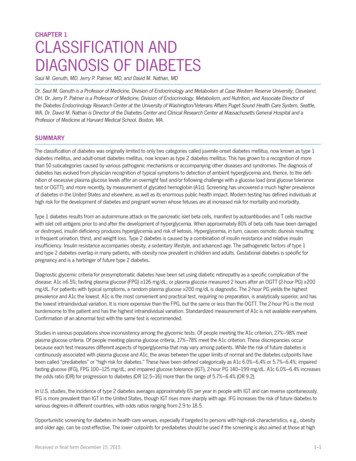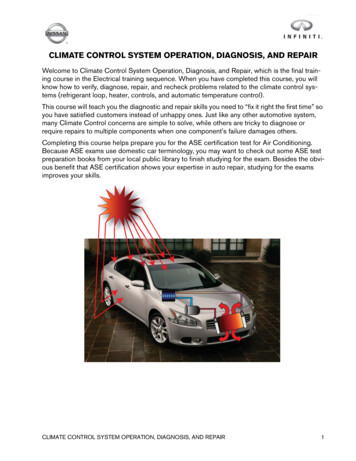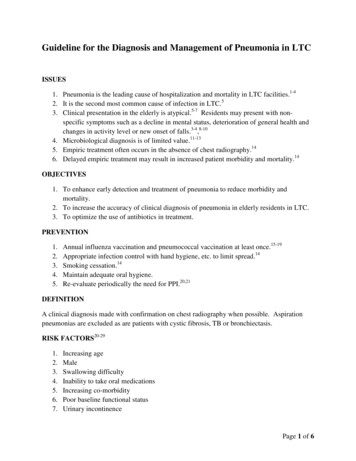
Transcription
Guideline for the Diagnosis and Management of Pneumonia in LTCISSUES1. Pneumonia is the leading cause of hospitalization and mortality in LTC facilities.1-42. It is the second most common cause of infection in LTC.53. Clinical presentation in the elderly is atypical.5-7 Residents may present with nonspecific symptoms such as a decline in mental status, deterioration of general health andchanges in activity level or new onset of falls.3-4,8-104. Microbiological diagnosis is of limited value.11-135. Empiric treatment often occurs in the absence of chest radiography.146. Delayed empiric treatment may result in increased patient morbidity and mortality.14OBJECTIVES1. To enhance early detection and treatment of pneumonia to reduce morbidity andmortality.2. To increase the accuracy of clinical diagnosis of pneumonia in elderly residents in LTC.3. To optimize the use of antibiotics in treatment.PREVENTION1.2.3.4.5.Annual influenza vaccination and pneumococcal vaccination at least once.15-19Appropriate infection control with hand hygiene, etc. to limit spread.14Smoking cessation.14Maintain adequate oral hygiene.Re-evaluate periodically the need for PPI.20,21DEFINITIONA clinical diagnosis made with confirmation on chest radiography when possible. Aspirationpneumonias are excluded as are patients with cystic fibrosis, TB or bronchiectasis.RISK FACTORS20-291.2.3.4.5.6.7.Increasing ageMaleSwallowing difficultyInability to take oral medicationsIncreasing co-morbidityPoor baseline functional statusUrinary incontinencePage 1 of 6
8. Inadequate oral hygiene9. Witnessed aspiration10. Histamine receptor blockers and PPIETIOLOGY1,5,8,12,13S. pneumonia, H. Influenza, Gram negative Bacilli (Enterobacteraceae), S. Aureus, atypicalorganisms (Legionella spp., Chlamydia pneumonia)ASSESSMENT30Physical examination must include blood pressure, heart rate, respiratory rate and auscultation ofthe respiratory system.DIAGNOSIS311. If CXR is unavailable then at least 2 of the following signs and symptoms of lowerrespiratory tract infection:a) Tachypnea, RR 25 per minuteAND/ORb)c)d)e)f)Fever, oral temperature 37.9oc or a 1.5oC above baseline temperatureNew onset productive coughPleuritic chest painNew or increased crackles, wheezes, rales, rhonchi or bronchial breath soundsNew onset delirium and/or decreased level of consciousness2. If CXR is available then confirmation of pneumonia on imaging with 1 clinical sign orsymptom of:a) New onset productive coughb) Fever, oral temperature 37.9oC or a 1.5oC increase above baseline temperaturec) Tachypnea with a respiratory rate 25 breaths per minuteTachypnea with a RR 25 breaths per minute has a sensitivity of 90% and a specificity of 95%for the diagnosis of pneumonia.32-33 It is the only physical sign for which a predictive value canbe determined for LTC residents.14 RR 25 is associated with increased morbidity andmortality.33 In 44.5% of elderly patients with pneumonia, delirium or acute confusion is found.14O2 saturation 90% is a strong predictor of hospitalization.35All symptoms must be new or acutely worse. Non-infectious causes such as congestive heartfailure should always be considered.Page 2 of 6
Diagnostic ImagingChest radiograph is the gold standard for confirming the diagnosis of pneumonia.12 However, itis less sensitive than high resolution CT scans for the detection of pulmonary infiltrates.12 ManyLTC facilities do not have easy accessibility to imaging facilities.LaboratoryGram stain of sputum is neither as sensitive nor specific in diagnosing the etiological agent inpatients with community acquired pneumonia.8,12,33 Routine sputum culture is also neithersensitive nor specific for diagnostic purposes.TREATMENT35Mild-moderate Pneumonia in LTCFirst LineAmoxicillin1 g po TID10 daysAmoxicillin/clavulanate500mg po TID or875mg po BID500mg po BID10 days500mg po BID10 days500mg po BID or1g XL po OD500mg po OD onday 1 & then250mg po OD,days 2-5100mg po BIDon day 1 & then100mg po OD10 days750mg po OD5 daysCefuroximeCefprozilANY one of the abovebeta-lactam agents PLUSone of the following:ClarithromycinAzithromycinDoxycyclineOr any ONE of thefollowing:Levofloxacin10 daysProvides best coverageagainst S. Pneumonia.Provides bettercoverage of H.Influenza and M.Catarrhalis in patientswith COPD. May bepreferred in patientspost influenza as itprovides coverageagainst S. Aureus.5 days10 daysMonotherapy may notbe as efficacious asPage 3 of 6
Moxifloxacin400mg po OD10 dayscombination therapy inthe management ofpneumonia.Quinolones should begiven with caution ifthe resident hasreceived quinolonetherapy within theprevious 6 months,especially if withciprofloxacin.As above.MANAGEMENT141.2.3.4.5.6.Oxygen therapy if indicated for hypoxemia with O2 saturation 90%.Initiation of antibiotic therapy as soon as possible ( 4 hours) after diagnosis.Ensure adequate hydration including the use of hypodermoclysis in the absence of CHF.Use of analgesics/anti-pyretics for pain and fever respectively.There is NO indication for use of anti-tussives or cough suppressants.Reassess antibiotic therapy between 48 and 72 hours for evidence of response totreatment.For any failure of therapy, consider change in antibiotic treatment or transfer to acute caredepending on resident’s level of care status.REFERENCES1. El-Solh AA, Niederman MS and Drinka P. Nursing home-acquired pneumonia: a reviewof risk factors and therapeutic approaches. Curr Med Res Opin 2010;26(12):2707-2714.2. Muder RR et al. Nursing home-acquired pneumonia: an emergence department treatmentalgorithm. Curr Med Res Opin 2004;20:1309-1320.3. Medina-Walpole AM and Katz PR. Nursing home-acquired pneumonia. J Am GeriatrSoc 1999;47:1005-1015.4. Muder RR. Pneumonia in residents of long-term care facilities: Epidemiology, etiology,management and prevention. Am J Med 1998;105:319-330.5. Smith PW et al. SHEA/APIC Guideline: Infection prevention and control in the longterm care facility. Am J Infect Control 2008;36:504-535.6. Norman D and Toldedo S. Infections in elderly persons: an altered clinical presentation.Clin Geriatr Med 1992;8:713-719.7. Marrie TJ and Blanchard W. A comparison of nursing home-acquired pneumoniapatients with patients with community-acquired pneumonia and nursing home patientswithout pneumonia. J. Am Geriatr Soc 1997;45:50-55.Page 4 of 6
8. Public Health Agency of Canada. Infection Prevention and Control Guideline for thePrevention of Healthcare-Associated Pneumonia. 2010.9. Marrie TJ. Pneumonia in the long-term-care facility. Infect Control Hosp Epidemiol2002;23:159-164.10. Muder RR. Approach to the problem of pneumonia in long-term care facilities. CompTher 2000;26:255-262.11. Geckler R et al. Microscopic and bacteriological comparison of paired sputa andtranstracheal aspirates. J Clin Microbiol 1997;6(4):396-399.12. Mandell LA et al. Summary of Canadian Guidelines for the Initial Managemnt ofCommunity-acquired Pneumonia: An evidence-based updated by the CanadianInfectious Disease Society and the Canadian Thoracic Society. Can Respir J2000;7(5):371-382.13. Nicolle LE et al. Antimicrobial Use in Long-Term-Care Facilities. Infect Control HospEpidemiol 1996;17:119-128.14. TOP. The Diagnosis and Management of Nursing Home Acquired Pneumonia (NHAP).2008.15. Stevenson CG et al. Prevention of influenza and pneumonococcal pneumonia inCanadian long-term care facilities: How are we doing? CMAJ 2001;164(10:1413-1419.16. Prevention and control of influenza: recommendations of the Advisory Committe onImmunization Practices (ACIP). MMWR 1999;48(RR-04):1-28.17. Influenza vaccine 1999-2000. Med Lett Drugs Ther 1999;41:82-83.18. Pneumococcal vaccine. Med Lett Drugs Ther 1999;41:84.19. Squires SG and Spika JS. Protecting against invasive pneumococcal disease. Be wiseimmunize! CMAJ 1998;159(7):826-827.20. Euric DT et al. Recurrent Community-acquired Pneumonia in Patients Starting Acidesuppressing Drugs. The American Journal of Medicine 2010;123:47-53.21. Meijvis SCA et al. Microbial evaluation for proton-pump inhibitors and the risk ofpneumonia. Eur Respir J 2011;38:1165-1172.22. Loeb M et al. Risk ractors for pneumonia and other lower respiratory tract infections inelderly residents of long-term care facilities. Arch Inern Med 1999;159:2058-2064.23. Vergis EN et al. Pneumonia in longterm care: a prospective case-control study of riskfactors and impact on survival. Arch Intern Med 2001;161:2378-2381.24. Beck-Sague C, Banerjee S and Jarvis WR. Infectious disease and mortality amongnursing home residents. Am J Public Health 1993;83:1739-1742.25. Magaziner J et al. Prevalence and characteristics of nursing-home acquired infection inthe aged. J Am Geritri Soc 1991;39:1071-1078.26. Jacobson C and Strausbaugh LJ. Incidence and impact of infection in the nursing homecare unit. Am J Infect Control 1990;18:151-159;27. Setia U, Serventi I and Lorenz P. Nosocomial infections among patients in the long-termcare facility: spectrum, prevalence and risk factors. Am J Infect Control 1998;13:57-62.Page 5 of 6
28. Rantanen TK and Salo JA. Gastroesophogeal reflux disease as a cause of death; analysisof fatal cases under conservative treatment. Scand J Gastroenterol 1999;34:229-233.29. Quaglierello V et al. Modifiable risk factors for nursing home-acquired pneumonia. ClinInfect Dis 2005;40:1-6.30. Hutt E and Kramer WM. Evidence-based guidelines for mangemtn of nursing homeacquired pneumonia. J Fam Pract 2002;51(8):709-716.31. Loeb M et al. Development of Minimum Criteria for the Initiation of Antibiotics inResidents of Long-Term-Care Facilities: Results of a Consensus Conference. InfectControl Hosp Epidemiol 2001;22:120-124.32. McFadden JP, Eastweood HD and Briggs RS. Raised respiratory rate in elderlydehydrated patients. Clin Endorcriol 1984;20:626-627.33. High, KP et al. Clinical Practice Guideline for the Evaluation of Fever and Infection inOlder Adut Residents of Long-Term Care Facilities: 2008 Update by the InfectiousDiseases Soceity of America. Clin Infect Dis 2009;48:149-171.34. Chan Causone SB et al. Pneumonia and lower respiratory infections in nursing homeresidents: predictors of hospitalization and mortality. J Am Geriatr Soc 2007;55:414419.35. Anti-infective Review Panel. Anti-infective Guidelines for Community-acquiredInfections. 2012.Page 6 of 6
Diagnosis Algorithm of Pneumonia in LTCIf CXR is unavailable then at least 2 of the following signs and symptoms oflower respiratory tract infection:Tachypnea, RR 25 per minuteAND/ORFever, Temperature 37.9oc or a 1.5oC above baseline temperatureNew onset productive coughPleuritic chest painNew or increased crackles, wheezes, rales, ronchi or bronchial breath soundsNew onset delirium and/or decreased level of consciousness1
1.2.3.4.5.Nursing staff to assess resident with blood pressure, heart rate, respiratory rate and auscultation of the respiratory system.If symptoms and/or signs of pneumonia, nursing staff to contact primary health care provider for resident.Primary health care provider to assess resident and order CXR if available.If CXR unavailable, primary health care provider to empirically treat resident with antibiotics as soon as possible if indicatedAs indicated:-Oxygen therapy if indicated for hypoxemia with O2 saturation 90%.-Consider parenteral (IM) treatment if possible is unable to swallow or appears more toxic, not a candidate for transfer tohospital.-Ensure adequate hydration including use of hypodermoclysis in the absence of CHF.-Use of analgesics/anti-pyretics for pain and fever respectively.6. Reassess antibiotic therapy at 48 and 72 hours for evidence of response to treatment.7. For any failure of therapy, consider change in antibiotic treatment or transfer to acute care depending on resident’s level of care status.There is NO indication for use of anti-tussives or cough suppressants.2
Guideline for the Diagnosis and Management of Skin and SoftTissue Infections (SSTIs) in LTCISSUES1. SSTIs which are the third most common infection in LTC facilities1 are caused byinflammatory microbial invasions of the epidermis, dermis and subcutaneous tissue.2,32. Superficial, uncomplicated SSTIs include furuncles, abscesses, carbuncles, impetigo,erysipelas and cellulitis.2 Cellulitis is one of the most common types of SSTIs in longterm care.2,43. Management of furuncles, carbuncles and abscesses is surgical incision and drainage andwhen indicated the use of antibiotics.2,54. Be aware that rapidly worsening SSTIs may be the symptoms and signs of necrotizingfasciitis caused by Group A β-hemolytic Streptococcus. Necrotizing fasciitis is amedico-surgical emergency.2,65. Be aware of MRSA when managing SSTIs.2,5,76. Clinically uninfected wounds do NOT require antibiotic therapy.87. Cultures of specimens obtained from superficial swabs cannot differentiate betweencolonization and infection.4OBJCTIVES1. To increase the accuracy of clinical diagnosis of skin and soft tissue infections forresidents in LTC.2. To improve resident outcomes through decreased morbidity and mortality associated withsoft tissue infections.3. To optimize the use of laboratory services.4. To optimize antibiotic therapy use (narrow spectrum antibiotic at the correct dose, and forthe correct duration) to reduce the development of antibiotic resistance and nosocomialinfections such as C. difficile.5. To optimize the appropriate prescribing of antibiotics.PREVENTION3,81. Conduct skin breakdown risk assessments for all residents. Reassess risk on a regularbasis.2. Inspect skin daily.3. Optimize nutrition and hydration.4. Manage moisture.5. Minimize pressure.DEFINITIONS7Page 1 of 7
Impetigo is a superficial skin infection of the epidermis which usually occurs on exposed areas ofthe body, most frequently the face and extremities7.Cutaneous abscesses are collections of pus within the dermis and deeper skin tissues. A furuncleor “boil” is an infection of the hair follicle, in which suppuration extends through the dermis intothe subcu
1. Nursing staff to assess resident with blood pressure, heart rate, respiratory rate and auscultation of the respiratory system . 2. If symptoms and/or signs of pneumonia, nursing staff to contact primary health care provider for resident. 3. Primary health care provider to assess resident and order CXR if available. 4. If CXR unavailable, primary health care provider to empirically treat resident with
